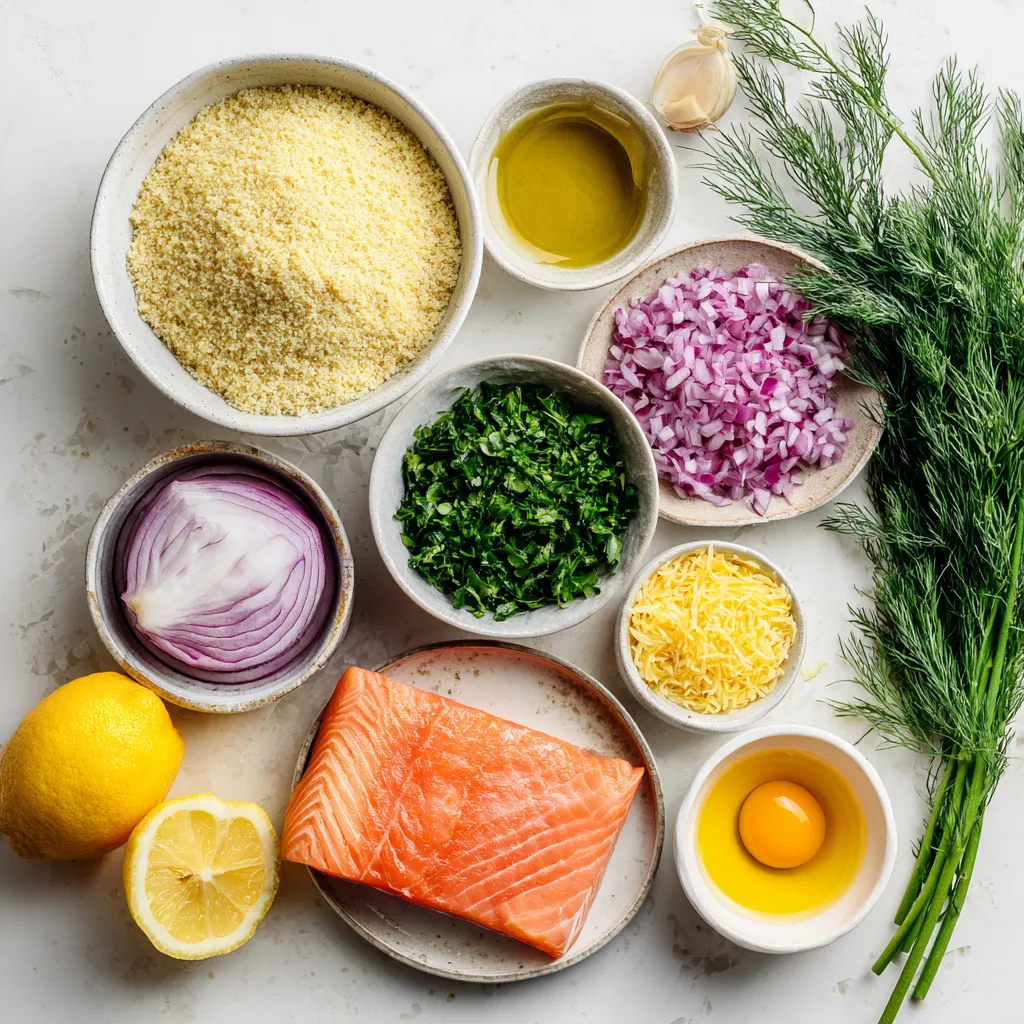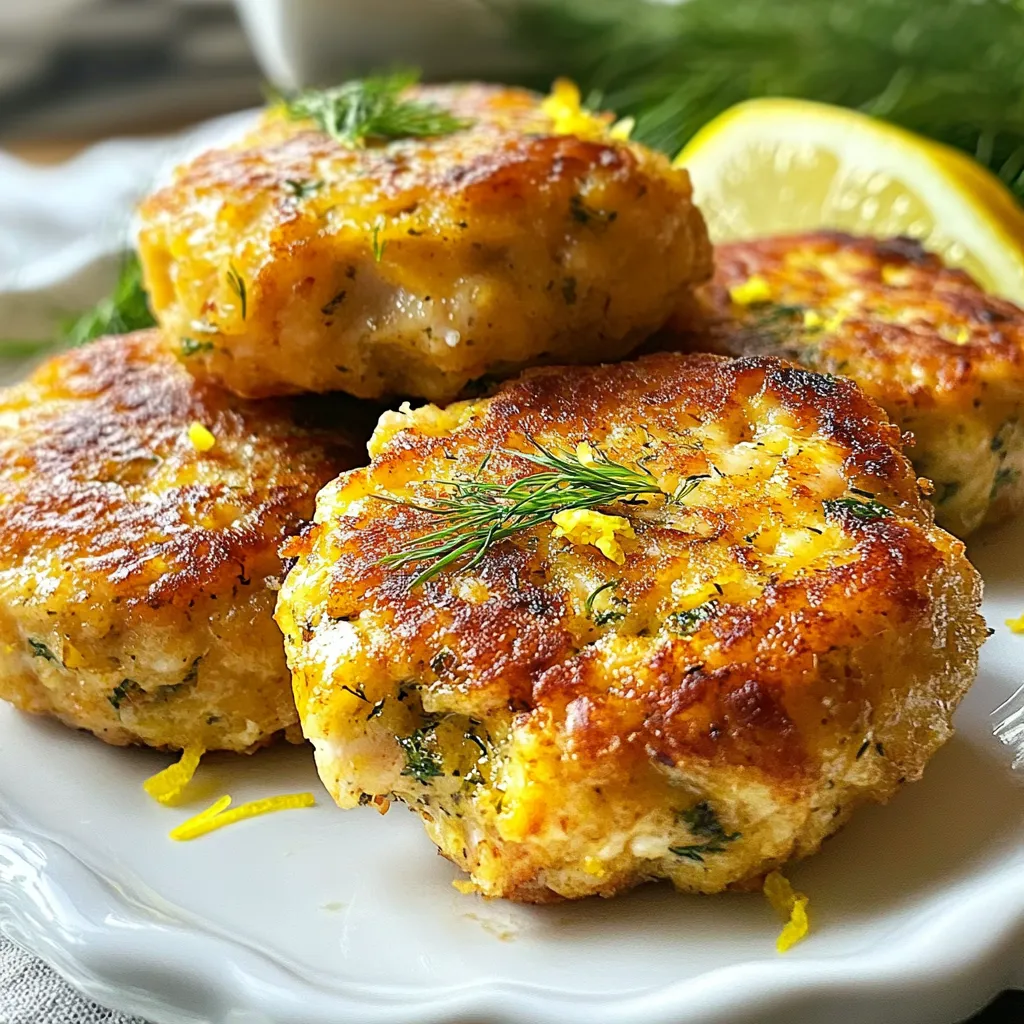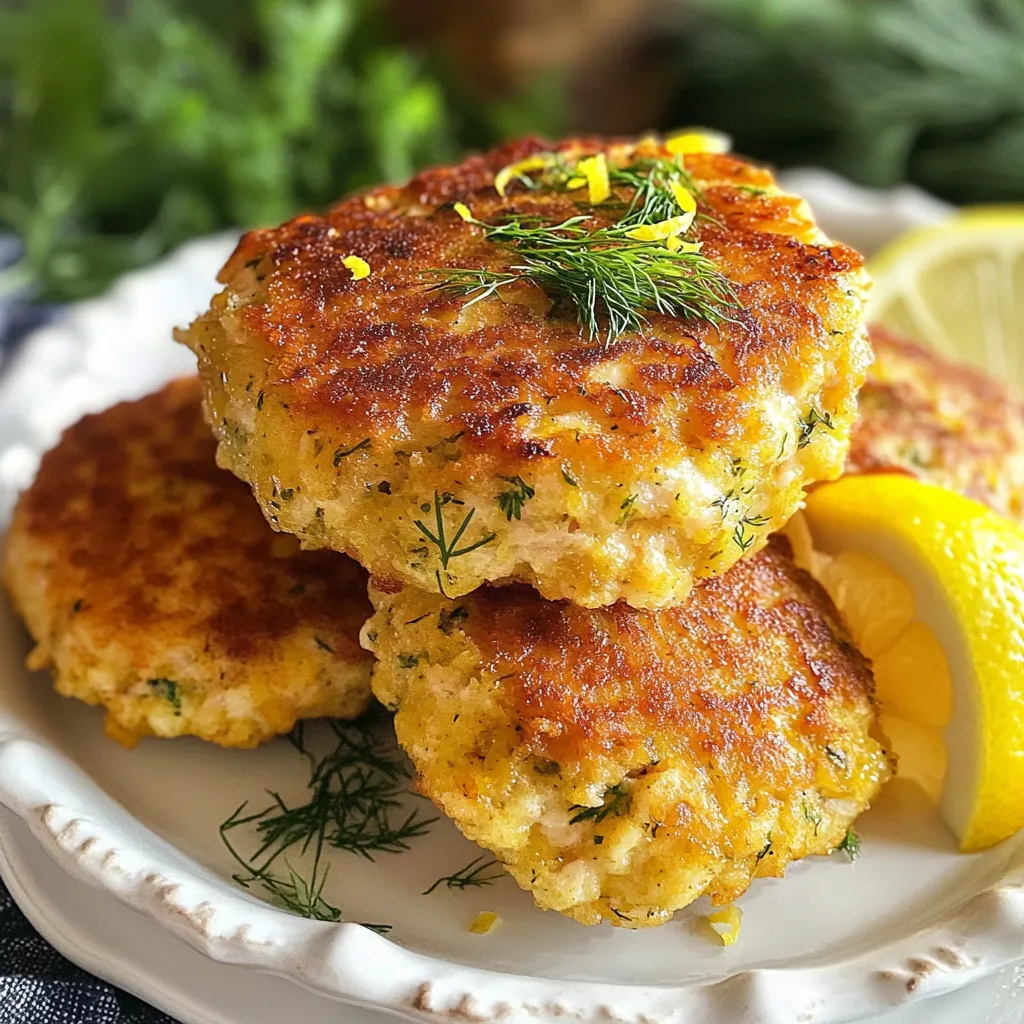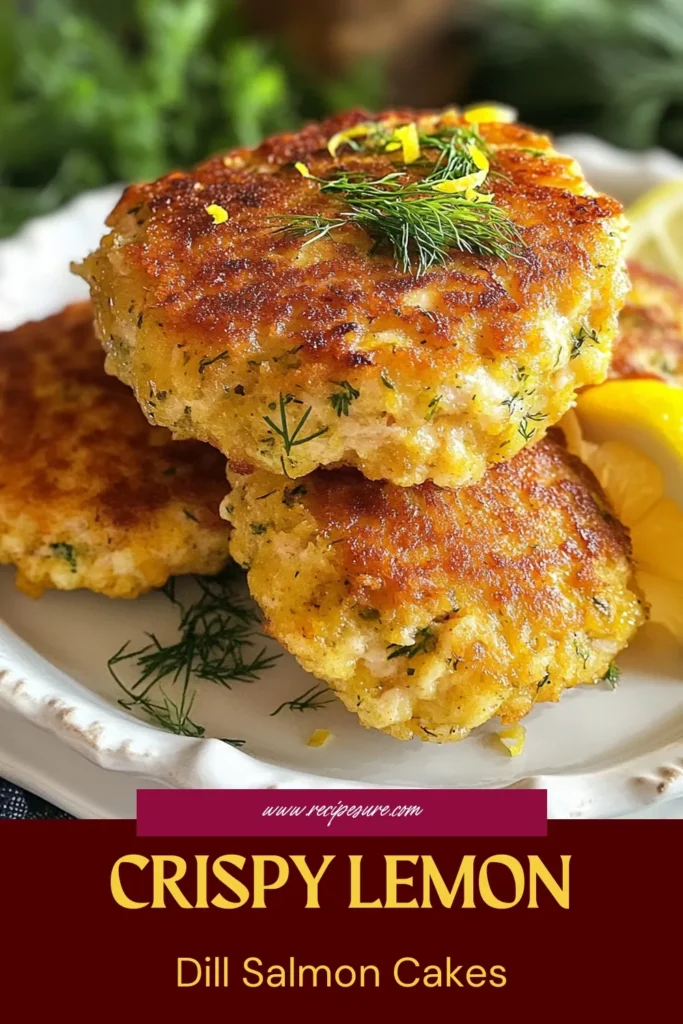Looking for a tasty and simple meal idea? These Lemon Dill Salmon Cakes are your answer! Packed with flavor and easy to make, this recipe is perfect for any skill level. I’ll guide you through each step, from selecting the right ingredients to cooking the perfect patties. Soon, you’ll serve up delicious salmon cakes that impress family and friends. Ready to dive in? Let’s get cooking!
Why I Love This Recipe
- Fresh Flavors: The combination of lemon and dill gives these salmon cakes a bright and refreshing taste that elevates the dish.
- Quick and Easy: This recipe takes only 25 minutes from start to finish, making it perfect for a busy weeknight dinner.
- Healthy Option: Using wild-caught salmon provides a nutritious protein source, packed with omega-3 fatty acids.
- Versatile Serving Suggestions: These salmon cakes can be served with a variety of sides, from salads to sauces, making them adaptable for any meal.
Ingredients
Main Ingredients for Lemon Dill Salmon Cakes
To make Lemon Dill Salmon Cakes, you need a few key items. Here’s what you will need:
- 1 can (14.75 oz) wild-caught salmon, drained and flaked
- 1/2 cup breadcrumbs (preferably panko for crunch)
- 1/4 cup finely chopped red onion
- 1/4 cup fresh parsley, chopped
- 2 tablespoons fresh dill, chopped
- Zest of 1 lemon
- 2 tablespoons lemon juice
- 1 large egg, beaten
- Salt and pepper to taste
- 2 tablespoons olive oil (for frying)
These ingredients come together to create a tasty dish. The salmon offers protein and healthy fats. The breadcrumbs help bind the cakes while adding crunch. Fresh herbs like parsley and dill bring bright flavors. Lemon zest and juice add a zing that wakes up the taste buds.
Optional Ingredients for Enhanced Flavor
While the main ingredients work great, you can add a few extras for more flavor. Here are some ideas:
- Garlic powder for a savory kick
- Old Bay seasoning for a classic seafood taste
- Chopped bell peppers for extra color and crunch
- A dash of hot sauce for heat
These additions can help personalize your salmon cakes. Feel free to mix and match based on your taste.
Common Substitutions
If you don’t have some ingredients on hand, don’t worry. Here are common swaps:
- Use canned tuna instead of salmon for a different fish flavor.
- Swap panko breadcrumbs with regular breadcrumbs if that’s all you have.
- Try dried dill if fresh isn’t available, but use less.
- Replace olive oil with vegetable oil for frying.
These substitutions keep the dish simple yet delicious. Always feel free to get creative with what you have in your kitchen!

Step-by-Step Instructions
Preparation of Ingredients
First, gather your ingredients. You need one can of wild-caught salmon, breadcrumbs, and some fresh herbs. Here’s what to prepare:
- 1 can (14.75 oz) wild-caught salmon, drained and flaked
- 1/2 cup breadcrumbs (preferably panko for crunch)
- 1/4 cup finely chopped red onion
- 1/4 cup fresh parsley, chopped
- 2 tablespoons fresh dill, chopped
- Zest of 1 lemon
- 2 tablespoons lemon juice
- 1 large egg, beaten
- Salt and pepper to taste
- 2 tablespoons olive oil (for frying)
Make sure to drain the salmon well before you start. This step helps the cakes hold their shape. Chop the herbs and onion finely. This gives the cakes a nice flavor and texture.
Mixing and Forming Patties
Now, let’s mix everything together. In a large bowl, add the flaked salmon, breadcrumbs, red onion, parsley, dill, lemon zest, and lemon juice.
Next, add the beaten egg. This helps bind the mixture. Season with salt and pepper. Use your hands or a spatula to mix gently. Be careful not to overmix. You want a good texture for the cakes.
Once mixed, form the mixture into patties. Aim for 2-3 inches in diameter and about 1 inch thick. You should make about 6-8 patties. Place them on a plate as you go.
Cooking the Salmon Cakes in Skillet
Heat your skillet over medium heat. Add the olive oil and let it warm up. It should shimmer but not smoke.
Carefully place the patties in the skillet. Make sure not to overcrowd them. This helps them cook evenly. Cook each side for about 4-5 minutes. You want them golden brown and crispy.
When flipping the patties, do it gently to keep them from breaking. Once they are cooked, transfer them to a paper towel-lined plate. This will help drain any extra oil.
Now, your lemon dill salmon cakes are ready to enjoy! Serve them warm and pair them with tartar sauce or a fresh salad for a tasty meal.
Tips & Tricks
Best Practices for Cooking Salmon Cakes
To cook salmon cakes well, you need the right heat. Use medium heat to avoid burning. Preheat the skillet with olive oil until it shimmers. This ensures a crispy crust.
Avoid overcrowding the pan. If you add too many patties, they will steam instead of fry. Cook in batches if needed. This helps each cake brown evenly.
How to Achieve the Perfect Texture
Texture matters in salmon cakes. You want them crispy outside and tender inside. Use panko breadcrumbs for crunch. They help create that perfect bite.
Don’t overmix the ingredients. Mix just until combined. Overmixing makes the cakes tough. Form the patties gently, about 2-3 inches wide. This size cooks well without falling apart.
Serving Suggestions and Pairings
Lemon dill salmon cakes shine with simple sides. Serve them warm with tartar sauce for a zesty kick. A fresh green salad adds color and crunch.
Try pairing with a light, tangy dip. A yogurt-based sauce works great. This adds creaminess without heaviness. Enjoy your salmon cakes with a squeeze of fresh lemon for extra flavor.
Pro Tips
- Use Fresh Herbs: Fresh dill and parsley will enhance the flavor of your salmon cakes significantly compared to dried herbs.
- Chill the Patties: For firmer patties, refrigerate them for 30 minutes before frying. This helps them hold their shape while cooking.
- Monitor the Heat: Ensure the oil is hot enough before adding the patties to achieve a crispy exterior. Too low heat may cause them to fall apart.
- Experiment with Breading: Try different types of breadcrumbs, like crushed crackers or cornmeal, for unique textures and flavors in your salmon cakes.

Variations
Healthier Alternatives for Salmon Cakes
You can make Lemon Dill Salmon Cakes healthier with a few easy swaps. Instead of breadcrumbs, try using oats or crushed nuts. These options add fiber and healthy fats. For a lighter dish, bake the salmon cakes instead of frying them. Just brush them with a little olive oil and place them in the oven at 375°F for about 20 minutes.
Flavor Variations and Add-ins
Get creative with flavors! You can add different herbs like thyme or basil for a unique twist. For a spicy kick, mix in chopped jalapeños or a dash of hot sauce. You can even add diced bell peppers or corn for extra color and texture. Each change brings a new taste to your salmon cakes, making them fun to explore.
Gluten-Free and Paleo Options
If you follow a gluten-free diet, substitute regular breadcrumbs with gluten-free ones or almond flour. These options work great and keep the cakes tasty. For a Paleo-friendly dish, use almond flour instead of breadcrumbs. Also, ensure your salmon and other ingredients are free from any additives. These small changes keep the essence of the dish while fitting your dietary needs.
Storage Info
How to Store Leftover Salmon Cakes
To store leftover salmon cakes, let them cool first. Place them in an airtight container. Keep them in the fridge. They will last for about 3 days. If you plan to eat them later, wrap them tightly in plastic wrap before placing them in a container. This keeps them fresh and tasty.
Reheating Tips
When ready to eat, reheat the salmon cakes. You can use the oven or a skillet. For the oven, preheat to 350°F (175°C). Place the cakes on a baking sheet and heat for 10-12 minutes. For a skillet, add a little olive oil over medium heat. Cook each side for about 3-4 minutes until warm and crispy. This method helps keep the cakes crunchy.
Freezing Instructions
To freeze salmon cakes, start by cooling them completely. Then, lay them on a baking sheet in a single layer. Freeze for about 1 hour. Once frozen, transfer them to a freezer-safe bag or container. Label the bag with the date. They can stay in the freezer for up to 2 months. When you want to eat them, thaw in the fridge overnight before reheating.
FAQs
How long do Salmon Cakes last in the fridge?
Salmon cakes can last in the fridge for up to 3 days. Make sure to keep them in an airtight container. This keeps them fresh and prevents any odors from other foods.
Can I use fresh salmon instead of canned?
Yes, you can use fresh salmon. Just cook it first, then flake it. Fresh salmon adds a nice texture and flavor. It also makes the dish feel special. Use about 1 cup of cooked, flaked salmon for this recipe.
What can I serve with Lemon Dill Salmon Cakes?
You can serve lemon dill salmon cakes with a fresh salad. A simple green salad works well. You can also pair them with tartar sauce or yogurt sauce for dipping. Roasted vegetables or sweet potato fries make great sides too.
This blog post shares delicious lemon dill salmon cake recipes you can enjoy. I covered the key ingredients and cooking steps, along with helpful tips. You learned variations for different diets and how to store and reheat leftovers.
Salmon cakes are easy to make and perfect for any meal. Try these ideas to make your cooking fun and tasty. Now you have all the tools to impress your family and friends with great salmon cake

Lemon Dill Salmon Cakes
Ingredients
- 1 can wild-caught salmon, drained and flaked
- 0.5 cup breadcrumbs (preferably panko for crunch)
- 0.25 cup finely chopped red onion
- 0.25 cup fresh parsley, chopped
- 2 tablespoons fresh dill, chopped
- 1 lemon zest
- 2 tablespoons lemon juice
- 1 large egg, beaten
- to taste salt and pepper
- 2 tablespoons olive oil (for frying)
Instructions
- In a large mixing bowl, combine the flaked salmon, breadcrumbs, chopped red onion, parsley, dill, lemon zest, and lemon juice.
- Add the beaten egg to the mixture and season with salt and pepper. Mix everything gently until well combined but do not overmix.
- Form the mixture into patties, about 2-3 inches in diameter and 1 inch thick. You should yield about 6-8 patties.
- Heat olive oil in a large skillet over medium heat.
- Once the oil is hot, carefully place the salmon patties in the skillet, ensuring not to overcrowd the pan.
- Cook for about 4-5 minutes on each side, or until golden brown and crispy. Flip gently to avoid breaking the patties.
- Once cooked, transfer the patties to a paper towel-lined plate to drain any excess oil.
- Serve warm with a side of tartar sauce or a fresh green salad for a refreshing meal.

